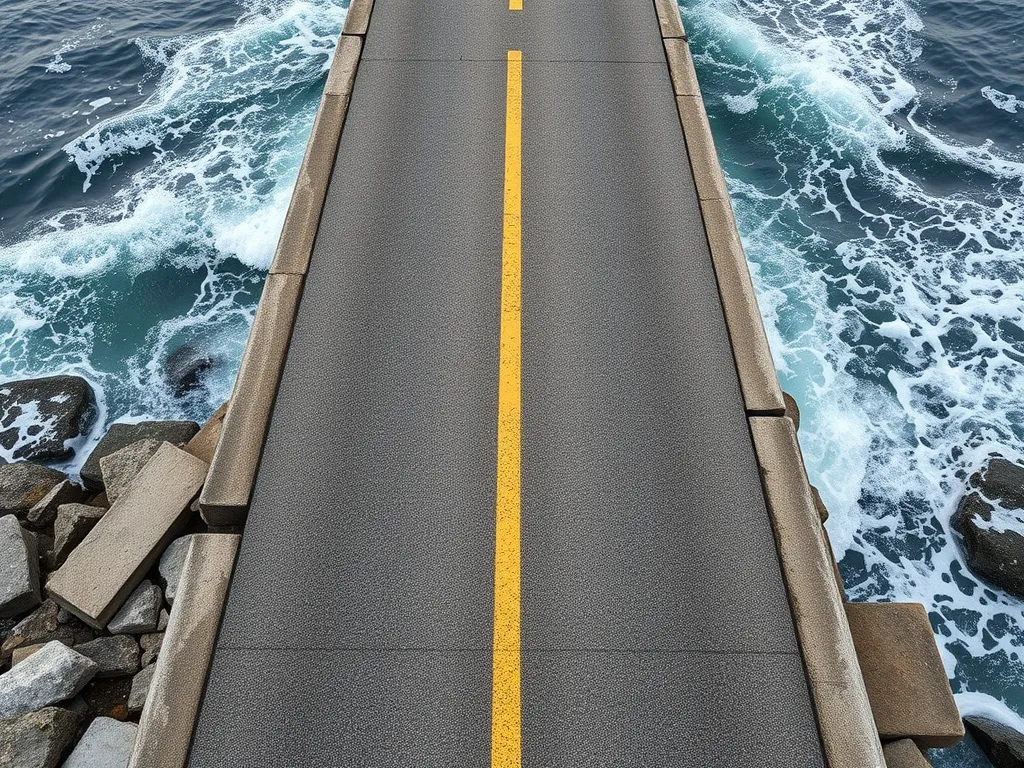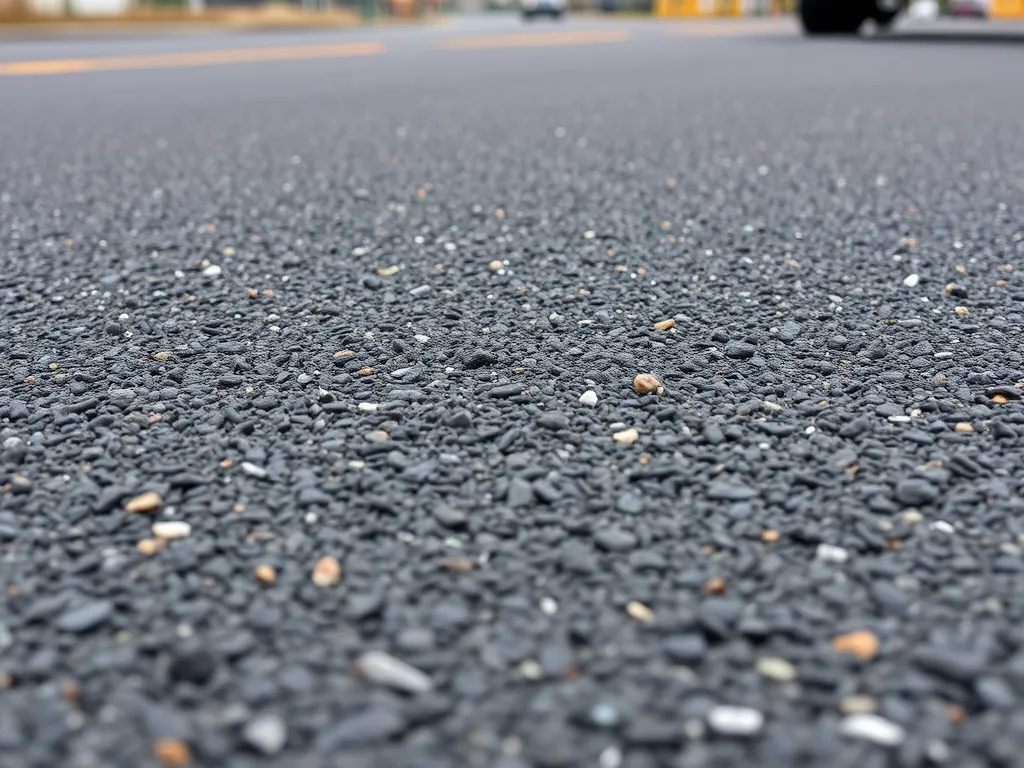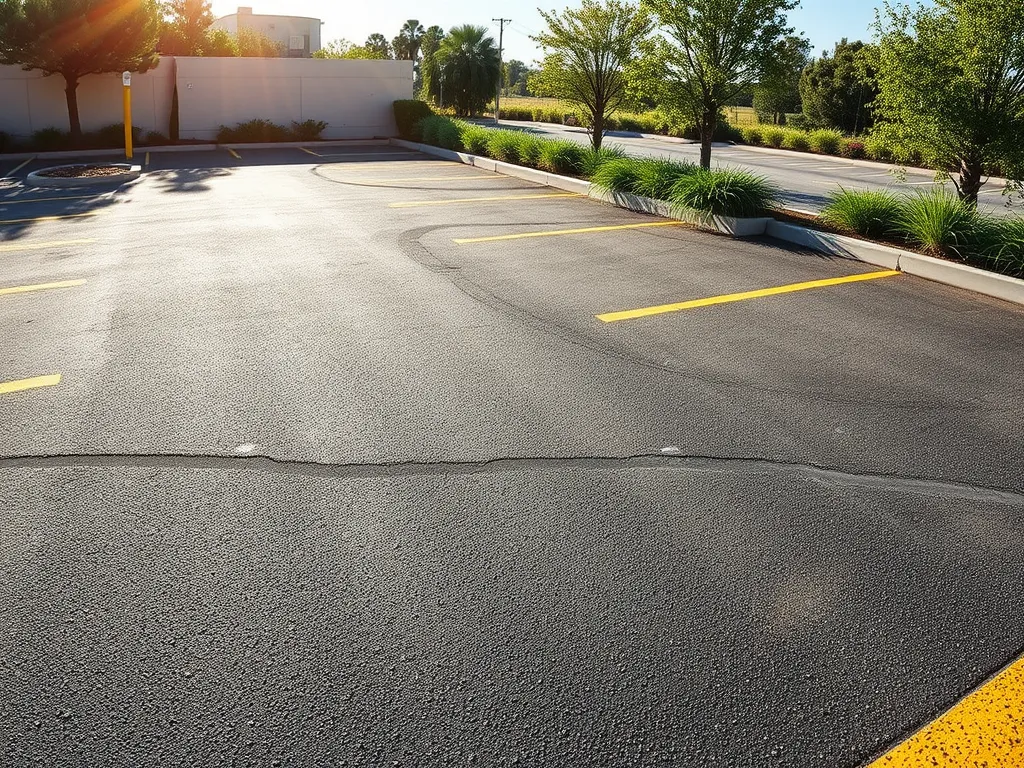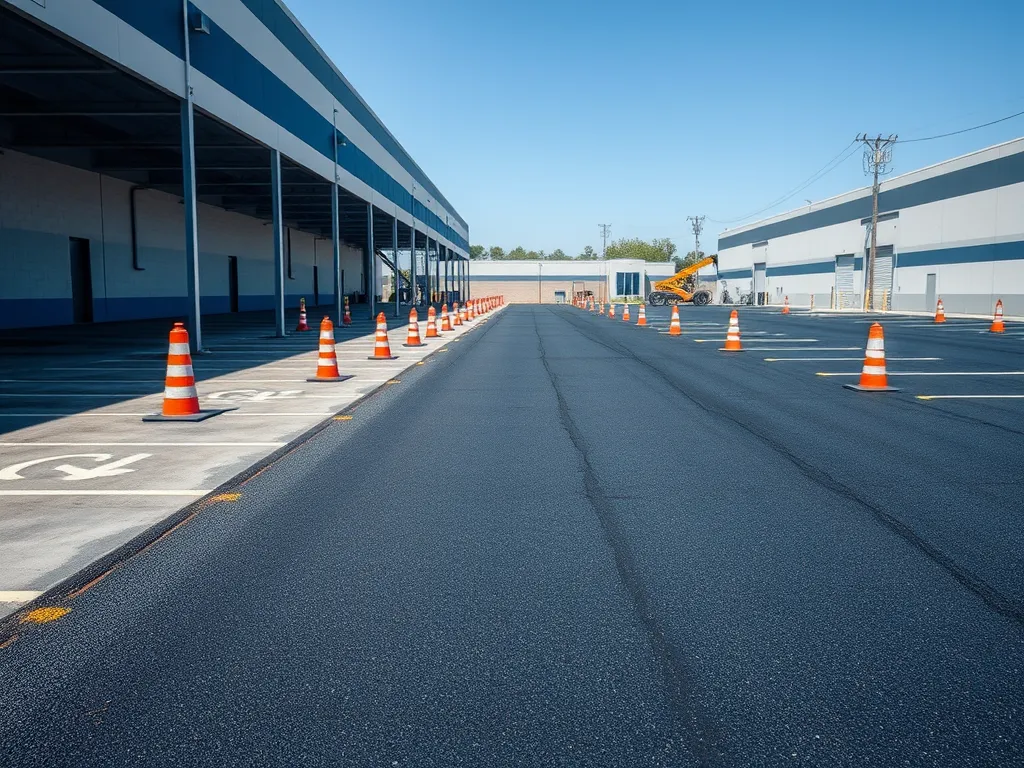Best Asphalt Mix for Parking Lots: Strength Meets Value
Published on: August 25, 2025 | Last Updated: April 14, 2025
Written By: George Voss
The best asphalt mix for parking lots uses hot mix asphalt (HMA) with 95% crushed stone aggregates and 5% asphalt cement binder. Type 1 (fine-graded) suits standard car traffic, while Type 2 (coarse-graded) handles delivery trucks and heavier loads. Key specs include 3-4 inches of compacted thickness, PG 64-22 performance-graded binders for temperature flexibility, and 1.5-2% slope for drainage. Costs range $3-$5 per square foot installed, lasting 15-20 years with sealcoating every 3-5 years.
This guide breaks down how to pick the right mix for your climate, traffic, and budget. Learn why aggregate size matters in freeze-thaw zones, how California mixes combat UV damage, and when recycled asphalt cuts costs by 20%. We’ll compare Type 1 vs. Type 2 compaction rates, explore permeable options for stormwater management, and share pro tips for avoiding cracks and potholes.
Contents
- Understanding Asphalt Mix Basics
- Key Factors in Choosing the Best Parking Lot Asphalt Mix
- Asphalt Mix Designations: Type 1 Vs. Type 2
- Recommended Thickness for Parking Lot Asphalt
- Asphalt Mix Components and Proportions
- Climate-specific Considerations: Best Mix for California
- Comparing Asphalt to Alternative Parking Lot Surfaces
- Best Practices for Parking Lot Asphalt Installation
- Environmental Impact Of Parking Lot Asphalt Mixes
- FAQs About Parking Lot Asphalt Mixes
- Closing Thoughts
- Additional Resources for You:
Understanding Asphalt Mix Basics
Parking lots demand asphalt that holds up to constant car traffic, shifting loads, and harsh conditions. Choosing wrong can lead to cracks, rutting, or costly repairs. Knowing how asphalt works forms a basis for smart paving choices.
What is Asphalt Mix?
Asphalt mix binds crushed stone (aggregates) with a sticky black glue called bitumen. Think of it as a rocky cake held together by thick syrup. Hot-mix asphalt (HMA), made at 300°F, is standard for parking areas. It flows smoothly during paving and locks aggregates tightly once cooled. Cold mixes work for temporary patches but lack HMA’s lasting grip.
Key Components Of Parking Lot Asphalt Mix
Four parts shape a parking lot’s asphalt quality:
Aggregates (94-95%): Crushed granite or limestone (1/2″ to 3/4″ size) forms the mix’s skeleton. Sharp, angular stones interlock better than round gravel. Fines (tiny particles) fill voids, boosting density.
Bitumen (5-6%): This petroleum-based glue coats aggregates. PG 64-22 binder is common—it stays flexible from -22°F to 150°F. High-traffic lots might use polymer-modified bitumen for extra toughness.
Additives: Fibers or rubber crumb (up to 5%) prevent cracking. Recycled asphalt pavement (RAP) can replace 20-30% of virgin material, cutting costs by $8-$15 per ton.
Air voids (3-5%): Tiny gaps let asphalt expand in heat without buckling. Too few voids cause rutting; too many let water seep in.
With a grasp of asphalt mix fundamentals, factors like traffic patterns and local weather dictate which formula works best.
Key Factors in Choosing the Best Parking Lot Asphalt Mix
Selecting the right parking lot asphalt mix requires balancing structural needs with environmental demands. Two elements dictate success: how much weight the surface must bear and how it holds up under local weather extremes.
Traffic Volume and Weight Load Requirements
Parking lots serving delivery trucks or heavy equipment need mixes with higher stability. For passenger vehicles, 4-6% binder content works. Heavy-duty zones require 6-8% binder with crushed stone aggregates (3/4” size). Engineers measure traffic using ESALs (Equivalent Single Axle Loads):
| Vehicle Type | ESALs per 1,000 Trips | Recommended Mix |
|---|---|---|
| Sedans | 0.02 | Type 3 (PG 64-22 binder) |
| Delivery Vans | 0.3 | Type 4 (PG 70-22 binder) |
| Garbage Trucks | 2.5 | Polymer-modified PG 76-22 |
High-traffic zones benefit from stone-matrix asphalt mixes. These include fiber additives to prevent rutting under repeated loads.
Climate and Weather Resistance Needs
Temperature swings destroy poorly formulated mixes. In northern states, binders like PG 58-28 resist thermal cracking below -10°F. Southern lots need PG 70-22 to prevent softening at 150°F pavement temps. Coastal regions require mixes with 5% limestone filler to block salt corrosion.
Rain-prone zones need porous mixes with 16-20% void space. These drain 5-7 inches of water per hour, reducing hydroplaning risks. For UV protection, surface mixes integrate carbon black pigments. These cut oxidation rates by 40%, extending pavement life beyond 15 years.
Next, we’ll break down how mix designations like Type 1 and Type 2 perform under these conditions.

Asphalt Mix Designations: Type 1 Vs. Type 2
Parking lot construction demands distinct asphalt mixes for structural integrity. Type 1 (coarse-graded) contains 3/4″ aggregates with 4-6% PG 64-22 binder, ideal for high-traffic zones. Type 2 (dense-graded) uses 1/2″ aggregates and 5-7% PG 58-28 binder, common in standard lots. Both follow Superpave specs but vary in load capacity.
Grade Differences for Parking Lot Applications
Type 1 works as a base layer due to its 98% crushed stone content, supporting 40-50 PSI truck traffic. Type 2 serves surface layers with 12.5mm nominal size, handling 20-30 PSI passenger cars. Parking stalls often pair a 4″ Type 1 base with a 2″ Type 2 top. Hot-mix asphalt (HMA) remains standard, but warm-mix variants cut paving temps to 250°F for workability.
Compaction and Stability Requirements
Type 1 needs 92-95% density via 10-ton rollers to hit 1,200-lb Marshall Stability. Type 2 targets 95-98% density with 8-ton rollers, achieving 1,800-lb stability for crack resistance. Air voids stay below 7% to block water infiltration. Joints require 145°F minimum temps during rolling to avoid cold spots. Poor compaction slashes pavement lifespan by 30-40%.
Nailing compaction sets up success for discussing ideal thickness. What specs apply to base vs. surface layers?
Also See: Bio-based Asphalt Innovations: Revolutionizing Roads
Recommended Thickness for Parking Lot Asphalt
Parking lot durability starts with proper layer dimensions. The right asphalt mix for parking lots performs best when paired with precise thickness specs that match traffic demands and local soil conditions.
Ideal Layer Thickness for Vehicle Traffic
Light vehicle areas (cars, vans) need 3 inches of surface mix over 4-6 inches of aggregate base. Heavy truck zones require 4 inches of surface layer with 8-12 inches of base. High-traffic lots with semi-trucks use PG 64-22 binders in 5-inch surfaces paired with stabilized subgrades.
Base Layer Vs. Surface Layer Specifications
Base layers prioritize load distribution, using 1.5-2 inch crushed stone aggregates at 95% compaction. Surface layers focus on smoothness and weather resistance, blending 3/8-inch aggregates with 5-7% asphalt cement. Top mixes like Superpave SP-III include polymer-modified binders for crack resistance in freeze-thaw zones.
Getting thickness right impacts pavement lifespan: underbuilt lots fail 3-5 years sooner. Next, let’s break down how material ratios affect performance in different climates.

Asphalt Mix Components and Proportions
Parking lot asphalt mixes combine aggregates, binder, and filler materials. The right blend determines load capacity, weather resistance, and surface longevity. Let’s break down the science behind durable blacktop.
Optimal Aggregate Size and Binder Ratios
Parking lots need aggregates that balance stability and smoothness. Use 1/2″ to 3/4″ angular crushed stone (granite or limestone) for base layers. Surface mixes work best with 3/8″ aggregates – small enough for tire contact yet durable against shear forces.
Bitumen content typically ranges 5-7% by weight. PG 64-22 binder (Performance Grade) handles most climates, resisting rutting up to 140°F and cracking at 22°F. Heavy truck areas may require 6.5% binder with polymer modifiers like SBS for extra elasticity.
Parking Lot Asphalt Mix Ratio Guidelines
Standard parking lot mixes follow these proportions:
- 90-95% aggregates (crushed stone, sand, gravel)
- 5-10% asphalt binder
- 0.5-2% mineral fillers (limestone dust)
For heavy-traffic commercial lots, use 93% aggregates + 7% PG 76-28 binder. Residential lots can drop to 5% binder with PG 58-34 in freeze-thaw zones. Recycled Asphalt Pavement (RAP) replaces up to 30% virgin material without compromising integrity.
With precise material ratios established, climate becomes the next critical factor – particularly for regions like California with extreme heat and UV exposure.
Climate-specific Considerations: Best Mix for California
California’s extreme heat and intense sun demand specialized asphalt mixes. Parking lots here face temperatures exceeding 100°F and UV exposure that can degrade standard pavements. Mix design must account for thermal expansion, surface softening, and rapid water runoff during rare heavy rains.
Heat-resistant Mix Formulations
PG 70-22 asphalt binder dominates California parking lots due to its high-temperature performance grade. This polymer-modified binder resists rutting at 158°F while staying flexible during cooler nights. Mixes often blend 5-7% binder with crushed granite aggregates for added rigidity. Rubberized asphalt containing 15-20% recycled tire crumb reduces heat absorption by up to 7°F compared to conventional mixes.
Drainage and UV Protection Requirements
Open-graded friction course (OGFC) mixes with 15-25% air voids handle sudden downpours common in Southern California. These porous layers channel 300-500 gallons of water per hour away from surfaces. UV-resistant additives like carbon black or zinc oxide extend pavement life by blocking 95% of harmful rays. Sealcoats with acrylic polymers applied every 24-36 months prevent oxidation damage.
With the right thermal and weather adaptations, California parking lots can last 12-15 years before major repairs. Up next: how asphalt compares to concrete and gravel for durability and cost.

Comparing Asphalt to Alternative Parking Lot Surfaces
Surfacing choices directly influence parking lot performance. While concrete or gravel might seem like viable options, their limitations become clear when matched against modern asphalt mixes designed for vehicular use.
Durability Vs. Concrete and Gravel
Parking lot asphalt mix outperforms concrete in flexibility. While concrete lasts 20-40 years, it cracks under freeze-thaw cycles without expansion joints. Gravel costs less upfront but shifts under tires, requiring regrading 2-3 times yearly. Asphalt surfaces withstand 10,000-30,000 PSI loads with proper compaction, bending slightly under weight without structural failure. PG 64-22 binders in mixes prevent rutting in 90°F+ heat while resisting cracks down to -20°F.
| Surface | Lifespan | Repair Cost/Sq Ft | Weather Resistance |
|---|---|---|---|
| Asphalt | 15-25 years | $0.75-$1.50 | High (PG-graded) |
| Concrete | 20-40 years | $2.00-$4.00 | Medium (joint cracks) |
| Gravel | 5-10 years | $0.10-$0.30 | Low (erosion) |
Cost-effectiveness Analysis
Initial installation for parking lot asphalt runs $2.50-$4.50 per square foot—higher than gravel ($1.00-$3.00) but lower than concrete ($4.00-$8.00). True savings emerge over time: sealcoating every 3-5 years at $0.15-$0.25 per square foot extends pavement life versus gravel’s $500-$1,000 annual regrading costs. Using 20-30% recycled material in mixes slashes new binder needs, cutting project budgets by 18-22%.
With performance metrics and lifecycle costs defined, let’s explore how correct installation methods lock in these benefits.
Best Practices for Parking Lot Asphalt Installation
Proper installation ensures your parking lot asphalt mix performs under pressure. Two factors dictate success: compaction quality and curing protocols.
Proper Compaction Techniques
Density matters. Parking lot asphalt mix requires 92-95% compaction of its maximum theoretical density (Rice density) to prevent premature cracking. Use vibratory rollers set to 1,500-3,000 vibrations per minute for base layers. Surface layers need static steel-wheel rollers to smooth finishes without displacing aggregates.
Temperature control is critical. Lay asphalt mix for parking lots at 275-300°F. Compact within 10 minutes of placement before temperatures drop below 185°F. For mixes with polymer-modified binders (PG 76-22), extend rolling time by 15% to account for higher stiffness.
| Aggregate Size | Roller Type | Passes Needed |
|---|---|---|
| 3/4″ | Vibratory | 6-8 |
| 1/2″ | Static | 4-6 |
Curing Time and Traffic Management
Fresh asphalt for parking lot paving needs 24-72 hours to cure. PG 64-22 binders harden faster in dry, 70°F+ weather—allow 24 hours before light traffic. In humid or sub-50°F conditions, extend curing to three days.
Block access with barricades or cones during curing. For emergency access, use plywood sheets to distribute vehicle weight. Post-installation, restrict heavy trucks (>10,000 lbs) for seven days to prevent rutting.
These practices set the stage for evaluating environmental impacts of parking lot asphalt mixes—a key factor in modern paving decisions.

Environmental Impact Of Parking Lot Asphalt Mixes
Parking lot mixes now balance strength with green gains. Builders pick eco-smart options to cut waste, manage water, and meet strict codes.
Recycled Material Integration
Top mixes use 20-30% RAP (Reclaimed Asphalt Pavement). This ground-up old asphalt cuts new bitumen needs by 15%. Caltrans specs allow 40% RAP in base layers. Some blends add RAS (Recycled Asphalt Shingles) for extra binder savings. Recycling 1 ton saves $35 in haul fees and keeps 0.03 cubic yards out of landfills.
| Recycled Type | Max % in Mix | Cost Cut |
|---|---|---|
| RAP | 30% | 20-25% |
| RAS | 5% | 8-12% |
Permeable Asphalt Options
Porous mixes drain 300-500 inches of rain per hour through 20% void spaces. These systems use open-graded stone (3/4″ size) and polymer-modified PG 76-22 binders. Install costs run $4-$7 per sq.ft. but may earn LEED credits. Check local codes – some states like FL mandate 50% stormwater soak.
| Feature | Standard Mix | Permeable Mix |
|---|---|---|
| Drain Rate | 0.1 in/hr | 400 in/hr |
| Base Depth | 6″ | 18″ |
Smart mix choices today prevent tomorrow’s repair headaches. Common queries arise when planning eco-driven lots – let’s tackle key questions head-on.
FAQs About Parking Lot Asphalt Mixes
What Are the Common Standards for Asphalt Mixes in Parking Lots?
Common standards for asphalt mixes in parking lots include Superpave specifications, which ensure the mix meets specific performance criteria regarding load-bearing capacity, durability, and weather resistance. Adhering to these specifications helps ensure longevity and stability under varying traffic conditions.
How Does Recycled Asphalt Affect Performance?
Recycled asphalt can impact performance positively by providing similar durability as virgin asphalt while reducing costs. When blended correctly, it enhances the binding properties and stability of the mix, resulting in a robust surface suitable for parking lots. However, it is essential to follow industry guidelines for the percentage of recycled material to ensure optimum performance.
What Role Do Additives Play in Asphalt Mixes?
Additives like fibers, rubber, or polymers enhance the performance of asphalt mixes by improving elasticity and crack resistance. They can also help reduce rutting under heavy loads and increase the overall lifespan of the pavement, making them valuable for high-traffic parking areas.
How Often Should Parking Lot Asphalt Be Sealcoated?
Parking lot asphalt should ideally be sealcoated every 3-5 years, depending on traffic and weather exposure. Sealcoating protects the asphalt from UV damage, water infiltration, and wear, extending its lifespan significantly if maintained properly.
What is the Importance Of Proper Drainage in Asphalt Parking Lots?
Proper drainage is crucial for asphalt parking lots as it prevents water accumulation, which can lead to cracking, potholes, and surface deterioration. Adequate drainage systems, such as slopes and permeable materials, help manage water runoff effectively, preserving the integrity of the asphalt over time.
Are There Specific Maintenance Practices for Parking Lot Asphalt?
Yes, key maintenance practices include regular inspections for cracks and potholes, timely repairs, periodic sealcoating, and ensuring proper drainage. Addressing issues promptly can significantly prolong the life of the asphalt surface and reduce long-term repair costs.
Closing Thoughts
Choosing the best asphalt mix for parking lots is vital for long-lasting performance. Consider factors like traffic volume, climate, and compaction requirements to ensure proper selection. An optimal mix not only enhances durability but also improves safety and cost-effectiveness.
Be mindful of local conditions and specifications when selecting your asphalt mix. Consulting with experienced professionals can further guide decisions, especially for climate-specific needs like heat resistance in California.
For more information on asphalt mixes and helpful tools, check out Asphalt Calculator USA. Your parking lot deserves the best!
Additional Resources for You:
- Yoder, E. J., & Witczak, M. W. (1975). Principles of Pavement Design (2nd ed.). New York, NY: Wiley.
- What Type of Asphalt is Best for Parking Lots? – Asphalt Paving
- Parking Lot Paving: Guide to Proper Thickness for Asphalt Parking Lots
- Choosing an Asphalt Mix for Your Parking Lot – Parking Lot Services
- Which Material is Best for Your Parking Lot? | One Stop Asphalt


